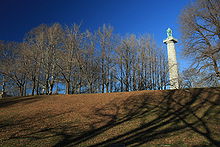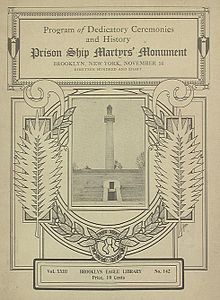- Prison Ship Martyrs' Monument
-
Coordinates: 40°41′30″N 73°58′32″W / 40.6918°N 73.9756°W
See also: Prison shipThe Prison Ship Martyrs' Monument in Fort Greene Park, in the New York City borough of Brooklyn, is a memorial to the more than 11,500 prisoners of war who died in captivity[1], known as the prison ship martyrs. The remains of a small fraction of all those who died on the ships are in a crypt below its base.
It consists of a 100-foot (30 m)-wide granite staircase and a central Doric column 149 feet (45 m) in height. At the top is an eight-ton urn. It was designed by renowned architect Stanford White (1853–1906), and its design is similar to doric column monuments around the nation and the globe.
It is sometimes called the tallest freestanding Doric column in the world when it was built[2], but the Monument to the Great Fire of London in London, Great Britain was built in 1671-77 and is 202 feet (62 m) in height.
More American soldiers and sailors died of intentional neglect in these ships than died on all the battlefields of the American Revolutionary War, combined.[3][4][5][6][7][8][9][10][11] One such ship was the HMS Jersey.
Contents
Origin
Following the end of the American Revolutionary War in 1783, an immediate reaction to preserve revolutionary heroism through monumental notions had grown in America. In regards to the Prison Ship incidents it was nearly two decades later until active attempts to commemorate their efforts were arranged. The initial proposal spawned from Matthew Davis who wrote an essay in 1794 in the Columbian Gazetteer in which he signed “A Lover to His Country”. His efforts brought him to find support from The Tammany Society. The Tammany Society during this period, was composed of various intellectual artisans, shopkeepers, shoemakers, merchants, and few trade members, which consisted of both Federalist Party and Democratic-Republican Party supporters. The Tammany Society specialized in acknowledging and praising wartime efforts or patriotism throughout history by conducting ceremonial meetings. This effort by the Tammany Society to commemorate the prison ships fell short due to political conflicts of interest between the two Congressional Parties within the Society.[12]
A series of interests to renew the idea of commemorating the fallen Martyrs who died on the Prison Ships during the Revolutionary War arose in the 1820s. Although little effort was gained another push for celebrating the memory of the deceased occurred in 1839.[when?] Benjamin Romaine, a former Tammany [sachem], bought the lot in Fort Greene Park (which is the current residing area for this monument). Romaine also provided a small amount of funding to organize committees for this process of preservation. This method also fell short after the death of Benjamin Romaine in 1844. However, his effort was not short-lived and gave enough influence to continue the commemoration. In 1873, the remaining bones of the fallen and other paraphernalia safely kept since the war, was moved to its current location. The monuments erection finally occurred in November 1908. In attendance for this prolonged, commemorative event was President-elect William Howard Taft and approximately twenty thousand spectators. Assistance for the construction of this monument came from Federal State funding,[clarification needed] municipal funds, and smaller contributors, such as the Tammany Society.[13]History and Facts
The Antiquities Act of 1906 was created by the office and assertion of Theodore Roosevelt. The Antiquities Act was originally created to allow the President to set aside for future generations federal land that held cultural or scientific interests for the United States. The significance from this Act of 1906 is that it was mainly geared towards National Monuments in America.[citation needed] The Prison Ship Martyrs Monument was the first “non-National” monument to coincide under the regulations of the Antiquities Act.[citation needed] The Fort Greene Park area site where the monument was constructed was under direct ownership of the white house because of the regulations set by the Antiquities Act in 1906.[14][15][16][clarification needed]
The current preservation and supervision of this monument belongs to the New York City Department of Parks and Recreation. Regular funding is necessary to continue the upkeep of the monument. A budgetary study was conducted from March 6, 2006 to September 5, 2008 on electrical improvements and the cost estimated to about $341,000. The overall restoration cost for the monument from 2006 to 2008 was an estimated $5,100,000.[17]
Recent history
A plaque was added in 1960, fifty two years later after the construction of the monument, in order to provoke a new world of public interest. The plaque is located opposite of the front label on the monument. Surrounding the monument stands an eight-tonne bronze urn and four 300-pound eagles. The text on the plaque reads:
“In memory of the 11,500 patriotic American sailors and soldiers who endured untold suffering and died on the prison British ships anchored in Wallabout Bay during the Revolutionary War 1776- 1782. Their remains lie buried in the crypt at the base of this monument which was dedicated on November 14, 1908. This plaque was afforded by The Society of Old Brooklynites on June 1, 1960. Farelly Crane M.D. President.”[18]
The memorial found issues with public attraction beginning in the 1960s following the production of the memorial plaque. The monument sustained numerous attacks of vandalism, consisting of theft of the bronze eagles and a plaque dedicated by the King of Spain.[citation needed] The rebirth of the monument chronologically matched the agenda of New York; restoring the culture in the city and cleaning up large public areas.[citation needed] This launched the renovation of the Prison Ship Monument with a $3.5 million budget in 2004.[19] Currently surrounding the monument are secured exhibits explaining the history of the Prison Ships, the Battle of Brooklyn and a list of the 8,000 known martyrs.[20] In 2008, a centennial commemoration was held.[21]
See also
- Prisoners in the American Revolutionary War
- HMS Jersey
- British Prison Hulks
External links
- New York City Department of Parks and Recreation text of sign near the monument.
- Prison Ship Martyrs Monument at Find A Grave
- Prison Ship Martyrs Monument, hmdb
- "In Our Midst: The Prison Ship Martyrs", mindful walker, September 30, 2010
References
- ^ Find A grave memorial on Prison ship monument lists 152 by name 5/24/2011
- ^ For example http://www.nycgovparks.org/parks/FortGreenePark/highlights/13308
- ^ Stiles, Henry Reed. "Letters from the prisons and prison-ships of the revolution." Thomson Gale, December 31, 1969. ISBN 978-1432812225
- ^ Dring, Thomas and Greene, Albert. "Recollections of the Jersey Prison Ship" (American Experience Series, No 8). Applewood Books. November 1, 1986. ISBN 978-0918222923
- ^ Taylor, George. "Martyrs To The Revolution In The British Prison-Ships In The Wallabout Bay." (originally printed 1855) Kessinger Publishing, LLC. October 2, 2007. ISBN 978-0548592175.
- ^ Banks, James Lenox. "Prison ships in the Revolution: New facts in regard to their management." 1903.
- ^ Hawkins, Christopher. "The life and adventures of Christopher Hawkins, a prisoner on board the 'Old Jersey' prison ship during the War of the Revolution." Holland Club. 1858.
- ^ Andros, Thomas. "The old Jersey captive: Or, A narrative of the captivity of Thomas Andros...on board the old Jersey prison ship at New York, 1781. In a series of letters to a friend." W. Peirce. 1833.
- ^ Lang, Patrick J.. "The horrors of the English prison ships, 1776 to 1783, and the barbarous treatment of the American patriots imprisoned on them." Society of the Sriendly Sons of Saint Patrick, 1939.
- ^ Onderdonk. Henry. "Revolutionary Incidents of Suffolk and Kings Counties; With an Account of the Battle of Long Island and the British Prisons and Prison-Ships at New York." Associated Faculty Press, Inc. June, 1970. ISBN 978-0804680752.
- ^ West, Charles E.. "Horrors of the prison ships: Dr. West's description of the wallabout floating dungeons, how captive patriots fared." Eagle Book Printing Department, 1895.
- ^ Cray, Robert E. Jr. “Commemorating the Prison Ship Dead: Revolutionary Memory and the Politics of Sepulture in the Early Republic.” In The William and Mary Quarterly. Third series, Vol. 56, No. 3 . 565-590. Chicago: Omohundro Institute of Early American History and Culture, 1999.
- ^ Cray, Robert E. Jr. “Commemorating the Prison Ship Dead: Revolutionary Memory and the Politics of Sepulture in the Early Republic.” In The William and Mary Quarterly. Third series, Vol. 56, No. 3 . 565-590. Chicago: Omohundro Institute of Early American History and Culture, 1999.
- ^ Friedlander, Lee. The American Monument. New Jersey: The Eakins Press Foundation, 1976.
- ^ Rothman, Hal. Preserving Different Pasts: The American National Monuments. Urbana and Chicago: University of Illinois Press, 1989.
- ^[not in citation given] Harmon, David, Francis P. McManamon and Dwight T. Pitcaithly. The Antiquities Act: a century of American archaeology, historic preservation, and nature conservation. Arizona: University of Arizona Press, 2006.
- ^ New York City Department of Parks and Recreation, “Capital Projects”, Parks & Recreation, http://www.nycgovparks.org/parks/FortGreenePark/capital
- ^ McDonnell, Sharon. “Revolutionary Martyrs’.” American Spirit: Daughters of the American Revolution. March/April 2007. 43-46.
- ^ http://www.nycgovparks.org/sub_about/parks_divisions/capital/pd_proj_month_oct_04.html
- ^ McDonnell, Sharon. “Revolutionary Martyrs’.” American Spirit: Daughters of the American Revolution. March/April 2007. 43-46
- ^ http://psmmonument.com/
1765 1770 1775 1776 - New York and New Jersey campaign
- Battle of Long Island
- New York Prison Ships Begin
- Submarine attack in New York Harbor
- Staten Island Peace Conference
- Landing at Kip's Bay
- Battle of Harlem Heights
- Great Fire of New York
- Execution of Nathan Hale
- Battle of Valcour Island
- Battle of Pell's Point
- Battle of White Plains
- Battle of Fort Washington
1777 - Meigs Raid
- Saratoga campaign
- Siege of Fort Ticonderoga
- Battle of Fort Anne
- Siege of Fort Stanwix
- Battle of Oriskany
- Battle of Bennington
- Battle of Setauket
- Battle of Staten Island
- Battle of Freeman's Farm (1st Saratoga)
- Battle of Forts Clinton and Montgomery
- Battle of Bemis Heights (2nd Saratoga)
1778 1779 1780 - Battle of Young's House
- First Purple Heart
- Arnold–André conspiracy exposed
- Battle of Fort St. George
1781 - HMS Culloden Runs Aground at Montauk
- Washington Calls Off Invasion of New York
- Battle of Fort Slongo
1782 1783 Categories:- American Revolutionary War prisoners of war
- American Revolutionary War sites
- Buildings and structures in Brooklyn
- Landmarks in New York City
- Monuments and memorials in New York
- Monumental columns in the United States
- United States military memorials and cemeteries
- New York in the American Revolution
- Martyrs' monuments and memorials
Wikimedia Foundation. 2010.


